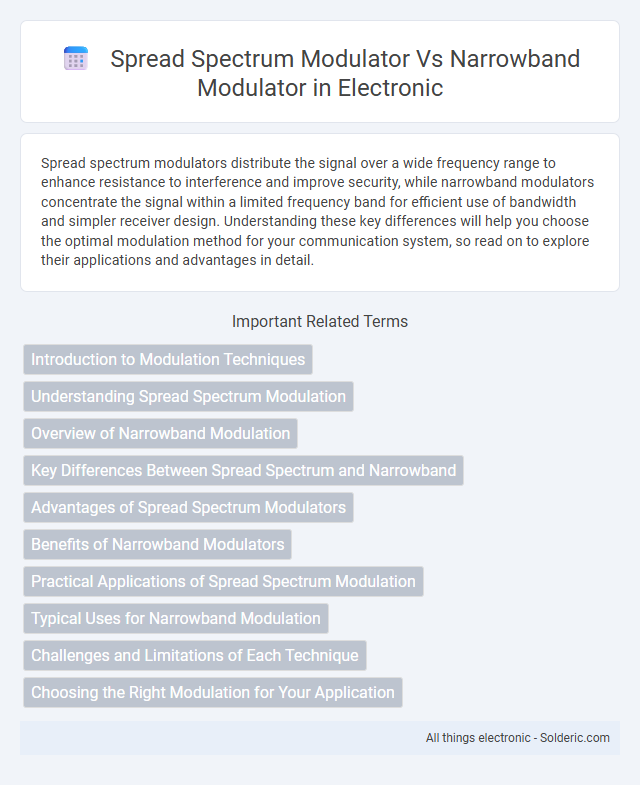Spread spectrum modulators distribute the signal over a wide frequency range to enhance resistance to interference and improve security, while narrowband modulators concentrate the signal within a limited frequency band for efficient use of bandwidth and simpler receiver design. Understanding these key differences will help you choose the optimal modulation method for your communication system, so read on to explore their applications and advantages in detail.
Comparison Table
| Feature | Spread Spectrum Modulator | Narrowband Modulator |
|---|---|---|
| Bandwidth Usage | Wide, spreads signal over a broad frequency range | Narrow, confines signal to a small frequency band |
| Interference Immunity | High resistance to narrowband interference | Low resistance; easily affected by interference |
| Security | Enhanced security due to signal spreading | Lower security; signal is easily intercepted |
| Signal Power Density | Low power density, less detectable | High power density, more detectable |
| Complexity | Complex modulation and demodulation processes | Simple modulation techniques |
| Applications | Military communications, GPS, wireless LANs | Conventional radio, narrowband data links |
| Data Rate | Typically lower data rate, depending on spreading factor | Higher data rate in limited bandwidth |
Introduction to Modulation Techniques
Spread spectrum modulators distribute signal energy across a wider frequency band, enhancing resistance to interference and eavesdropping compared to narrowband modulators, which concentrate energy on a narrow frequency range for higher spectral efficiency. Your choice between these modulation techniques depends on the application's requirements for robustness against noise, security, and bandwidth availability. Understanding these differences is crucial for optimizing communication system performance in environments ranging from wireless networks to military communications.
Understanding Spread Spectrum Modulation
Spread spectrum modulation spreads the signal over a wider bandwidth than the original data rate, enhancing resistance to interference, jamming, and eavesdropping. Narrowband modulators concentrate energy within a small frequency range, offering higher signal-to-noise ratio under stable conditions but lower resilience to distortion. Understanding the trade-offs between spread spectrum and narrowband modulation is crucial for applications in secure communications, wireless networks, and military systems.
Overview of Narrowband Modulation
Narrowband modulation transmits signals within a limited bandwidth close to the carrier frequency, optimizing spectral efficiency for applications like AM, FM, and QAM. This modulation type prioritizes high signal-to-noise ratio over wide frequency coverage, making it ideal for channels with constrained bandwidth. Compared to spread spectrum modulators, narrowband modulators offer simpler implementation and lower power consumption but are more susceptible to interference and eavesdropping.
Key Differences Between Spread Spectrum and Narrowband
Spread spectrum modulators distribute the signal across a wider frequency band, enhancing resistance to interference and providing increased security compared to narrowband modulators, which confine transmission to a narrow frequency range for higher spectral efficiency. Spread spectrum techniques, such as Frequency Hopping and Direct Sequence, reduce the impact of noise and multipath fading, making them ideal for robust wireless communication in noisy environments. Your choice between these modulators depends on the need for interference resilience versus bandwidth efficiency in the given application.
Advantages of Spread Spectrum Modulators
Spread spectrum modulators offer superior resistance to interference and multipath fading compared to narrowband modulators, enhancing signal reliability in congested environments. They provide increased security through frequency hopping or direct sequence techniques, making unauthorized interception and jamming more difficult. Their wide bandwidth use supports multiple access communications and reduces the impact of narrowband noise, improving overall system performance.
Benefits of Narrowband Modulators
Narrowband modulators provide enhanced spectral efficiency by concentrating the signal power within a limited frequency band, resulting in reduced interference and improved signal-to-noise ratio (SNR). They are ideal for applications requiring high data rates over short distances, such as point-to-point communication and certain wireless local area networks (WLANs). The compact bandwidth usage of narrowband modulators supports better coexistence with other systems and optimizes channel allocation in crowded frequency spectra.
Practical Applications of Spread Spectrum Modulation
Spread spectrum modulation is widely used in wireless communication systems such as GPS, Bluetooth, and Wi-Fi due to its robustness against interference and multipath fading, ensuring reliable data transmission across crowded frequency bands. Unlike narrowband modulators, spread spectrum techniques enhance security and resistance to jamming by spreading the signal over a wide frequency range, making it less susceptible to interception and intentional disruption. Your choice of modulation impacts system performance, with spread spectrum modulation particularly advantageous in environments requiring secure, interference-resistant communication.
Typical Uses for Narrowband Modulation
Narrowband modulation is typically used in applications requiring efficient spectrum usage and long-range communication with limited bandwidth, such as traditional AM/FM radio, two-way radios, and certain telemetry systems. It offers robust performance in environments with minimal interference, making it ideal for voice communications and low data rate transmissions. The focused bandwidth allows for simpler receiver designs compared to spread spectrum systems.
Challenges and Limitations of Each Technique
Spread spectrum modulators face challenges such as increased complexity in implementation and higher power consumption due to wider bandwidth usage, which can lead to spectrum inefficiency in crowded frequency environments. Narrowband modulators offer improved spectral efficiency and simpler design but suffer from susceptibility to narrowband interference and limited robustness in multipath fading or jamming scenarios. Both techniques encounter trade-offs between system complexity, interference resilience, and spectral efficiency, impacting their suitability for specific communication applications.
Choosing the Right Modulation for Your Application
Spread spectrum modulators offer robustness against interference and improved security by distributing signals over a wide frequency range, making them ideal for wireless communication in congested environments. Narrowband modulators provide higher spectral efficiency and simpler receiver designs, suited for applications requiring limited bandwidth and low power consumption, such as traditional voice communication or sensor data transmission. Selecting the right modulation depends on factors like interference levels, bandwidth availability, power constraints, and security requirements specific to your application.
Spread spectrum modulator vs narrowband modulator Infographic

 solderic.com
solderic.com